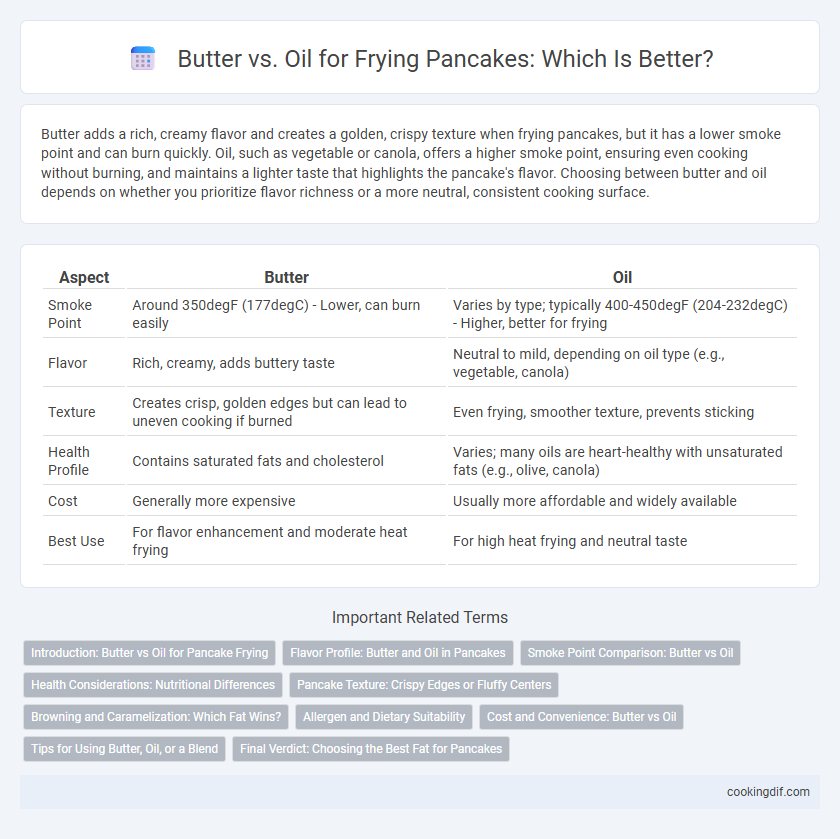Butter adds a rich, creamy flavor and creates a golden, crispy texture when frying pancakes, but it has a lower smoke point and can burn quickly. Oil, such as vegetable or canola, offers a higher smoke point, ensuring even cooking without burning, and maintains a lighter taste that highlights the pancake's flavor. Choosing between butter and oil depends on whether you prioritize flavor richness or a more neutral, consistent cooking surface.
Table of Comparison
| Aspect | Butter | Oil |
|---|---|---|
| Smoke Point | Around 350degF (177degC) - Lower, can burn easily | Varies by type; typically 400-450degF (204-232degC) - Higher, better for frying |
| Flavor | Rich, creamy, adds buttery taste | Neutral to mild, depending on oil type (e.g., vegetable, canola) |
| Texture | Creates crisp, golden edges but can lead to uneven cooking if burned | Even frying, smoother texture, prevents sticking |
| Health Profile | Contains saturated fats and cholesterol | Varies; many oils are heart-healthy with unsaturated fats (e.g., olive, canola) |
| Cost | Generally more expensive | Usually more affordable and widely available |
| Best Use | For flavor enhancement and moderate heat frying | For high heat frying and neutral taste |
Introduction: Butter vs Oil for Pancake Frying
Butter provides a rich, creamy flavor that enhances the taste of pancakes, while oil offers a neutral base that ensures even cooking without any added flavor. Butter tends to brown quickly due to its milk solids, creating a desirable golden crust but requiring careful temperature control to prevent burning. Oil, especially vegetable or canola, has a higher smoke point, making it more stable for frying pancakes at consistent temperatures.
Flavor Profile: Butter and Oil in Pancakes
Butter imparts a rich, creamy flavor with a slightly nutty undertone that enhances the sweetness of pancakes, creating a more indulgent taste experience. Oil, especially neutral vegetable oils, provides a subtle, clean taste that allows the pancake's natural flavors to shine without overpowering them. Choosing butter over oil results in a golden, slightly crisp edge with a distinctive, savory aroma, while oil offers a lighter, less aromatic finish.
Smoke Point Comparison: Butter vs Oil
Butter has a lower smoke point, typically around 350degF (177degC), which makes it prone to burning quickly and producing a bitter taste when frying pancakes. In contrast, oils like vegetable, canola, or avocado oil have higher smoke points ranging from 400degF to 520degF (204degC to 271degC), allowing for a more consistent cooking temperature and preventing burnt flavors. Choosing oil with a higher smoke point ensures pancakes cook evenly and develop a golden-brown crust without the risk of smoke or burnt butter residue.
Health Considerations: Nutritional Differences
Butter contains saturated fats and cholesterol, which can raise LDL cholesterol levels and increase the risk of heart disease, while oil--especially olive or avocado oil--offers healthier unsaturated fats that support cardiovascular health. Oils with high smoke points, such as canola or sunflower oil, maintain nutrient stability during frying, reducing the formation of harmful compounds compared to butter, which burns at lower temperatures. Choosing oils rich in omega-3 and omega-6 fatty acids enhances the nutritional profile of pancakes by promoting anti-inflammatory benefits and better lipid metabolism.
Pancake Texture: Crispy Edges or Fluffy Centers
Butter creates pancakes with rich, crispy edges due to its milk solids browning during frying, enhancing flavor and texture. Oil, with its higher smoke point and neutral taste, allows pancakes to cook evenly and maintain fluffy centers without burning. Choosing butter or oil directly impacts the balance between crispy edges and soft, fluffy interiors in pancake preparation.
Browning and Caramelization: Which Fat Wins?
Butter enhances pancake browning and caramelization due to its milk solids that promote Maillard reactions, creating a rich, nutty flavor and appealing golden crust. Oil, especially vegetable or canola, provides a higher smoke point, preventing burning and ensuring even cooking without compromising browning intensity. For optimal pancake texture and flavor, a combination of butter and oil balances browning benefits with heat stability.
Allergen and Dietary Suitability
Butter contains dairy proteins and lactose, making it unsuitable for individuals with dairy allergies or lactose intolerance, while oils such as vegetable or coconut oil are free of common allergens and suitable for vegan and dairy-free diets. Using oils that are allergen-free ensures safe frying for those with sensitivities to dairy components. For optimal dietary suitability, selecting non-dairy oils aligns better with vegan, lactose-intolerant, and dairy-allergic dietary restrictions.
Cost and Convenience: Butter vs Oil
Butter offers rich flavor but tends to be more expensive and requires careful temperature control to prevent burning, making it less convenient for frying pancakes. Cooking oil, such as vegetable or canola oil, is more cost-effective and has a higher smoke point, allowing for easier temperature management and quicker cleanup. For budget-friendly and hassle-free pancake frying, oil provides a practical advantage over butter.
Tips for Using Butter, Oil, or a Blend
Butter imparts rich flavor and browns pancakes quickly, but its low smoke point requires careful heat control to prevent burning. Oils like vegetable or canola offer higher smoke points and even cooking, making them ideal for consistent pancakes without scorching. Combining butter with oil balances taste and heat tolerance, ensuring golden, flavorful pancakes with less risk of burning.
Final Verdict: Choosing the Best Fat for Pancakes
Butter imparts a rich, creamy flavor and creates a golden, crispy edge that elevates pancake taste and texture, making it a preferred choice for many home cooks. Oil, with its higher smoke point, prevents burning and allows for even cooking, ideal for those seeking a neutral taste or dietary flexibility. For the best pancake experience, using clarified butter or combining butter with a high-smoke-point oil balances flavor and cooking performance effectively.
Butter vs oil for frying Infographic

 cookingdif.com
cookingdif.com